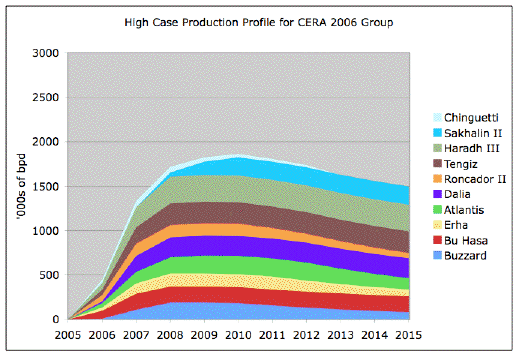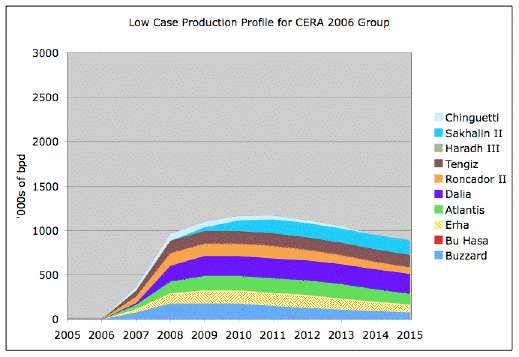Update on CERA 2006 Projects
Posted by Stuart Staniford on October 10, 2005 - 8:11pm
I've been continuing the process of researching production models for the CERA 2006 group of projects (after having started with 2005 here). Here's what I've been finding out.

High case production scenario for CERA 2006 listed projects.
- Buzzard is on track to start production at the end of 2006, reaching plateau of 190,000 bpd by "late 2007". Proved + probable reserves have been upgraded to 550mbl following more seismic surveys by new operator Nexen. The field will not stay at peak long with 190,000 bpd from a not-that-big field.
- I haven't found any further update on Bu Hasa (which is adding additional gas and water injection to increase production at an old field (discovered in 1962, initial full development completed in 1989, more gas injection in 1996, and this new project supposed to complete late 2006). It's somewhat hard to know how to account for these projects - will they really be new production increases, or essentially offset declines? I assume the former in the high case, and the latter in the low case. (It's worth noting that UAE production has been essentially in a bumpy plateau since 1991).
- The FPSO for Erha is now supposed to reach the field around the end of 2005 (so the project has slipped from the original goal of first oil in 4Q 2005.) First oil is now scheduled for H1 06 (presumably late in the half).
- Atlantis plans have been upgraded to 200kbpd, and are on track for first oil in Q3 2006. Since some of the expansion is for the more recently discovered northern part of the field, I'm estimating a longer than usual 18 months to get to peak production of 200k. Reserves are now at about 770mbl of oil. Atlantis appears to be unscathed by Katrina and Rita.
- Looks like Dalia is definitely for 240kbpd. Here's a nice article on the project. HO had mentioned Dalia as maybe going to 500,000 in the future, but I think that's a misreading of this reference, which I think is really saying that with this and other fields, Total is planning to get to 500,000 in Angola. Total's other main development in Angola is the Rosa field. According to BP, "Additional tie-back options including the Zinia, Orquidea and Perpetua discoveries are expected to maintain the Dalia plateau well into the next decade."
- I've been able to find out almost nothing new about the Roncador Phase II project. The Brazilian projects seem to be particularly difficult for an English speaker to research. Are any of our Brazilian readers able to enlighten us?
- The best information on the Tengiz field upgrade I've found is here. Looks like it is bringing in between 7 and 12 million tons per year, which is between 140kbpd and 240kbpd, and is expected to start coming on stream mid 2006.
- The most precise information about the Haradh III development seems to come from the Saudi technical folks who say it will come on stream in July 2006 and will plateau for 50 years at 300kbd. My high case scenario assumes this is true, while my low case assumes Haradh III merely offsets other Ghawar declines and makes zero net addition to supply.
- According to this now deleted press release, or the Shell version here, there are significant cost overruns and delays in the Sakhalin II phase 2 project (phase I involves a small amount of production seasonally, wherease phase II will produce an estimated 205kbd year round (including condensate). There's interesting backround on Sakhalin II in this 2004 annual report. While the tone is suitably upbeat for a corporate communication, reading between the lines you can see the range of issues the consortium is struggling with. There are no schedule promises whatsoever in the 2004 report. However, Shell seems to think that we're now looking at mid 2008.
- The small (75kbpd, 120mbl 2p reserves) Chinguetti project is on schedule for Feb 2006. More information here.

Low case production scenario for CERA 2006 listed projects. The big drop relative to the high case comes mainly from assuming the Middle East field rework projects only offset declines instead of being really new production.




~~~~~~~~~~~~~
This week we première the IHS projection scenario. Its model includes both a High & Low Estimate for URR. We have decided to use the former as that better facilitates its Extraction plateau. Only EIA has a larger URR. Its relatively low Production Peak allows a generous Extraction Plateau thru the Century and the longest "Exhaustion Exit" of our Scenarios.
As follow-up to last week's musings, we have commenced applying arbitrary URR's to some of the models. Five of the scenarios presented do not provide a large enuf URR to justify their ambitious Extraction forecasts. However, we are satisfied presently that this is a reflection of cautiousness or lack of similar definitions in the realm of URR more so than lack of study of fields coming on stream in the medium and long term. While we like the methodology of EIA's use of a combination of OGJ/USGS stats, its subsequent URR figure is the largest of the series. Thus we have chosen to use the AVG of the series and have applied it towards BP, IEA, OPEC & Total. As IHS has become the parent of CERA and Daniel Yergin makes announcements for them interchangeably, we have decided to use the IHS High Estimate URR figures for CERA.
This methodology allows TrendLines to illustrate each model as described in their Annual Outlooks and/or recent media updates. That some of them cannot live up to those claims will be accommodated and disclosed in a coming Footnotes caveat.
Only ASPO, Laherrère & Koppelaar address post-Peak production. We have applied the AVG of those series as a Depletion Rate on the other scenarios to exhaust their published or our attributed URR.
The Exhaustion Exit is demarked by each model's failure to produce 6-mbd (was 5-mbd).
And finally, a public "thanx" to Jean Laherrère for providing us with his API sourced data for the 1950-1999 Past Production component of the graph.
~~~~~~~~~~~~~~
Down the same page we've posted our September USA Energy Reserves Newsletter. It's been almost a year since we posted this one publicly and some readers of TheOilDrum may find some of the stats & graphs interesting...
Aha! No wonder the crude price is so low.
So has the US been stockpiling (at the expense of poorer countries), or has there been more supply than demand?
It is also interesting to note that the Crude Stocks started to really ramp up around May which is when Crude prices started to rise quite steeply. Did the buying involved with the stockpiling contribute to the higher price?
Definitely some very interesting graphs.
Burlington Resources Restores Two-Thirds of Halted Production in U.S. Gulf
Oct. 10 (Bloomberg) -- Burlington Resources Inc. said it restored about two-thirds of the oil and natural-gas production in the Gulf of Mexico that was halted by
Hurricane Rita.
Efforts are under way to return production equivalent to about 60 million cubic feet of daily natural gas production that remains halted, Houston-based Burlington said in a statement today.
Because of curtailments from hurricanes in the Gulf, third- quarter production was in the ``lower portion'' of previously announced estimates of 2.8 billion to 3 billion cubic feet of gas equivalent a day, the company said. Burlington is scheduled to report third-quarter earnings on Oct. 27.
Information on Petrobrás future production plans can be found in this "Business Plan 2006-2010 Conference", (large pdf warning!) dated August, 2005. In page 18 you can find a year by year graphic with field and predicted production until 2010.